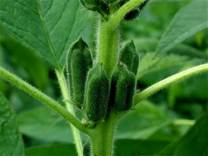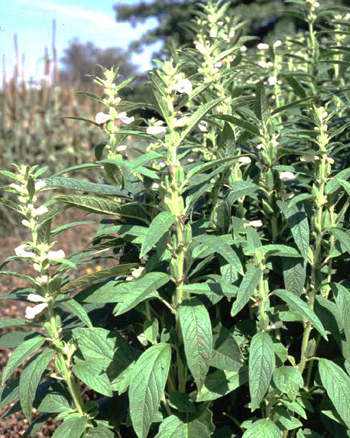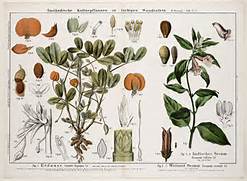Info dan Khasiat Bijan
Nama Vernakular : Bijan, Lenga
Nama Botani : Sesamum Orientale L
Famili : Pedaliaceae
Common Names
![]() Hei-chih-ma (Chinese name)
Hei-chih-ma (Chinese name)
![]() Sesame seed
Sesame seed
![]() Tila (Sanskrit name)
Tila (Sanskrit name)
Parts Usually Used
Seeds
Description of Plant(s) and Culture
Sesame is a strong, slender annual growing to 1 1/2-3 feet tall, with slender, dark-green leaves, 5 inches long, and inch-long, pale pink flowers, resembling foxglove, which lie along the square stem. The seeds vary in color: red, black, brown, or creamy white seeds. Seedpods will not develop without adequate moisture; requires watering during dry periods. It is a warmth-loving plant which will only mature its seeds in our southern states and Hawaii, though it may be started early in pots in the north and planted in the garden for decorative purposes. Full sun. Zones 8-10.
Another variety: The Chinese use a plant called sesame (Sesamum indicum) that they name Hu-ma. The famous general, Chang Chien, took the seed from the West to China when he made his
famous tour in the time of the Han dynasty.
Where Found
A native to Africa and the warmer parts of Asia. Naturalized from Florida to Texas, it is happiest in its native tropics and will grow in warm climates. Requires full sun and rich, moist soil.
Medicinal Properties
Demulcent, digestive, excretory, emollient, laxative, nutritive, tonic
Biochemical Information
Over 50% fatty oil, (including olein, linolein, palmitin, stearin and myristin), lecithin, choline, 1% oxalate acid, choroginic acid, vitamins E, A and B and appreciable amounts of calcium.
Legends, Myths and Stories
Earliest records show that sesame seed was a staple food and oil source in China, Japan, and India, and was used in ancient Greece. The Egyptians and Persians of Biblical times ground it into a kind of flour, from which they made bread. The Romans crushed the seed and used it like butter for a spread on bread. Today it is still used as a bread spread, the oil being used in the manufacture of some oleo-margarines.
Each plant produces only 1 tbsp. of seed, often none in cool climates.
One source claims that the halva candy is an aphrodisiac. It contains a rich supply of potassium and magnesium salts of aspartic acid. In addition, you get a bonus of vitamin E (called the fertility vitamin), calcium, phosphorus, and unsaturated fatty acids (vitamin F) as well as lecithin, and 50% more protein than meat. The hormone hypophyseal produced by the pituitary gland is basically protein in nature and obviously needs this nutrient in the diet for its development. This hormone is a key factor to healthy activity of the sex glands. So that is why some people call halva the Sex Candy.

Uses
Nourishes the liver and kidneys, lubricates dry intestines, darkens prematurely graying hair. Treats backache, tinnitus, blurry vision, migraines, vertigo or dizziness, chronic constipation, hemorrhoids, dysentery, amenorrhea, dysmenorrhea, receding gums, tooth decay, hair loss, weak bones, osteoporosis, emaciation, dry cough, blood in the urine, weak knees, stiff joints.
Because of its easily assimilated calcium content, it nourishes the blood, calms nervous spasms, and alleviates headaches, dizziness and numbness caused by deficient blood. Its a good tonic, particularly for the aged.
The oil of sesame will help burns, boils, ulcers, sunburn, remove freckles, age spots.
Formulas or Dosages
The seeds are thoroughly ground into powder and mixed into a paste with honey; take 2 tsp. daily. In the Middle East this mixture is eaten as a candy called halva. If you make your own, for variety add a dash of vanilla or maple flavoring, or add chopped nuts or dates. Shape into 2 tsp. balls or patties and refrigerate. Eat one patty per day. It has the consistency of fudge.
For dry cough, asthmatic and lung conditions, combine the powdered seeds with a pinch of black pepper, ginger juice, and honey. Take 1 tbsp. 3 times a day.
Nutrient Content
Carbohydrates, phosphorus, niacin, protein, calcium, vitamins C, E and A, and unsaturated fatty acids.
How Sold
Halva or Halvah bars can be obtained in health food stores but be sure to read the label, some are fortified with large amounts of sugar or corn syrup instead of honey. There are various flavors: vanilla, chocolate, and marbled, or with chopped nut covering.
You can buy sesame seeds at health food stores, mail order health food companies, herb companies, and even at some supermarkets or corner grocery stores.
Sumber : https://en.wikipedia.org/wiki/Sesame


Pingback: Rempah Ratus – Petua & Tips